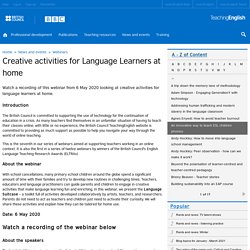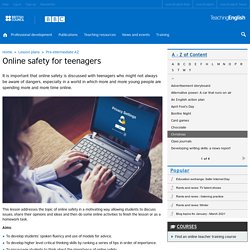

11 Low-Prep ESL Games for Teaching Online - BridgeUniverse. By Krzl Light Nunes May 19, 2020 670 Shares Share Tweet Pin Who doesn’t love playing games?

Film English – by Kieran Donaghy. English courses for kids. Four ways to keep young learners engaged in your online classes. Teachers and students around the globe are having to adapt to new ways of teaching and learning.

Although online classes are nothing new, many educators are now finding themselves having to quickly set up courses and content for their students, often without much previous experience. If you’re new to the virtual classroom, check out our six top tips for teaching English online. Different age groups have their challenges for virtual learning, so here are four ideas to help keep your youngest learners engaged during your online lessons. You searched for starters. Jane Ritter Anne Robinson Lauren Pitts Robert Martínez David Valente.

Creative activities for Language Learners at home. Introduction.

Dreams. Reading practice for kids. Inclusive Teaching Checklist. Daniel Sobel Daniel Sobel MA Ed (Psychology) FCMI FCIC FRSA is the Founder and Lead Consultant of Inclusion Expert.

An internationally respected leader in inclusive education, he has advised the Department for Education, the European Union and governments abroad. Rachael Roberts - Planning for differentiation. About the webinar The session will start by looking at some of the ways in which learners can differ from each other - needs, interests and abilities.

We will briefly consider the term 'mixed ability' and why 'differentiation' is becoming more popular, and what exactly it means. We will then explore a range of strategies for differentiating by task, teaching method and outcome. Differentiated Instruction: How to Make Lessons Accessible for All. A Video Series When some teachers think of differentiating instruction, they imagine having to create a different lesson for every student in the room.

“That insanity is not what differentiation is all about,” says veteran teacher and author Larry Ferlazzo. But what exactly is it? And how can teachers do it (without losing their minds)? Netflix and learn – six ways to teach English language skills with television. How can teachers of English create learning material with streaming services?

Melissa Thomson, a British Council teacher and trainer based in Bilbao, describes her top six approaches. Last year I asked my teenage learners to list the five places they were most likely to encounter English online, and the top answer was Netflix. Over 37 per cent of the world's internet users subscribe to Netflix, a streaming service for movies and television series. Almost everyone I know is a user of media-streaming services. Can we learn a second language like we learned our first? Robert William McCaul, winner (with Marek Kiczkowiak) of the TeachingEnglish blog award, examines the influential ideas of linguist Stephen Krashen, and the implications they have for the language classroom.

If you've ever doubted whether you're a good language learner, then bear in mind that you've already learned one language very well indeed – your first. But this raises an interesting question: can adults learn a second language in the same way they learned their first as children? And if so, what are the implications for the classroom? Stephen Krashen and the acquisition of languages Perhaps no-one has looked at the question more closely than the linguist Stephen Krashen, who has introduced some of the most influential concepts to the study of second-language acquisition. Krashen sums up the idea in a famous documentary on the subject called A child's guide to learning languages, produced by BBC Horizon in 1983. 1. Online voice recorder. HUNDREDS OF PRINTABLES - Make Beliefs Comix. Storyboard That: The World's Best Free Online Storyboard Creator.
Four ways to keep young learners engaged in your online classes. Building Rapport. Online safety for teenagers. This lesson addresses the topic of online safety in a motivating way, allowing students to discuss issues, share their opinions and ideas and then do some online activities to finish the lesson or as a homework task.

Aims: To develop students’ spoken fluency and use of modals for advice. To develop higher level critical thinking skills by ranking a series of tips in order of importance. Virtual Ice Breakers - Communication Skills From Mind Tools. © iStockphotopniesen Break down the communication barriers caused by remote working. Virtual ice breakers are a great way of overcoming one of the biggest challenges of managing a remote team – that is the lack of opportunities for team bonding. Guess what the photos are. Webwise - Internet Safety. How to use ClassDojo with PBIS. PBIS helps schools set consistent expectations across all classrooms, like "Helping others" and "Making good choices. " Teachers can add these expectations to their classes in ClassDojo and then give specific, positive feedback to students PBIS helps schools set consistent expectations across all classrooms, like "Helping others" and "Making good choices. " Teachers can add these expectations to their classes in ClassDojo and then give specific, positive feedback to students Teachers can give neutral feedback in ClassDojo to guide students toward classroom expectations.
To provide more details on what happened, teachers can add notes describing the rationale and intervention taken. This makes ClassDojo very useful as a Teachers can give neutral feedback in ClassDojo to guide students toward classroom expectations. Virtual Ice Breakers - Communication Skills From Mind Tools. The First Class. Even experienced teachers often feel nervous on day one with a new group and many claim that the adrenaline actually helps the class go well. So, don’t panic if you feel a few butterflies in your stomach. There are several things you can do to help make the first day less daunting and ensure that the class goes smoothly. Creative Spaces in Distance Learning. Creativity vs. creative teaching First, let us define the difference between teaching for creativity versus creative teaching. In the first, we are developing creativity in learners, and in the later, educators are teaching in a creative way.
The main difference between the two is, who gets to do the creative work — the teacher or the student? “Jump Around!” The Benefits of Movement in the Online Learning Process. We have all been there– sitting in class or a meeting, and after 20 minutes our knees begin to feel stiff, our lower backs start to pinch, our feet suddenly want to squirm. Soon, our attention shifts from the task at hand to the agonizing need to simply stretch. Nothing is worse than sitting in a statuesque-like pose and trying to maintain focus.
The same can be said for those in online learning classrooms. Notice that the cringy example progressed from physical stiffness, aches, and discomfort to mental distraction from the material. Video Backgrounds for Teachers (FREE Download) Building Rapport in the Online Classroom. Student smiling after being greeted by online teacher. LearnEnglish Kids. Helping parents and caregivers to support remote learning at home. Art For Kids Hub - Art Lessons - How To Draw For Kids. Guess what the photos are. The image in English Language Teaching. Each of these leading experts provide insightful articles and practical ideas for using still and moving images in language education.
The list of contributors include Ben Goldstein, Anna Whitcher, Antonia Clare, Paul Driver, Sylvia Karasthati, Paul Dummett, Magdalena Wasilewska, Andreia Zakime, Elena Domínguez Romero, Jelena Bobkina, Candy Fresacher, Tyson Seburn, Chrysa Papalazarou, Magdalena Brzezinska, Emma Louise Pratt, Samantha Lewis, Jean Theuma, and Valéria Benévolo França who are all also members of the Visual Arts Circle, a collective which provides a wide range of resources for you to use and encourages discussion and debate around the use of images in language teaching. The book includes a preface by Gunther Kress, Professor of Semiotics and Education in the Department of Culture, Communication and Media Within the Institute of Education of University College London.
Memory Game: Going to the seaside (foreign language - 3º Elementary - beach) TeachingEnglish. The Principles. Revising Your Teaching Philosophy for Distance Learning.